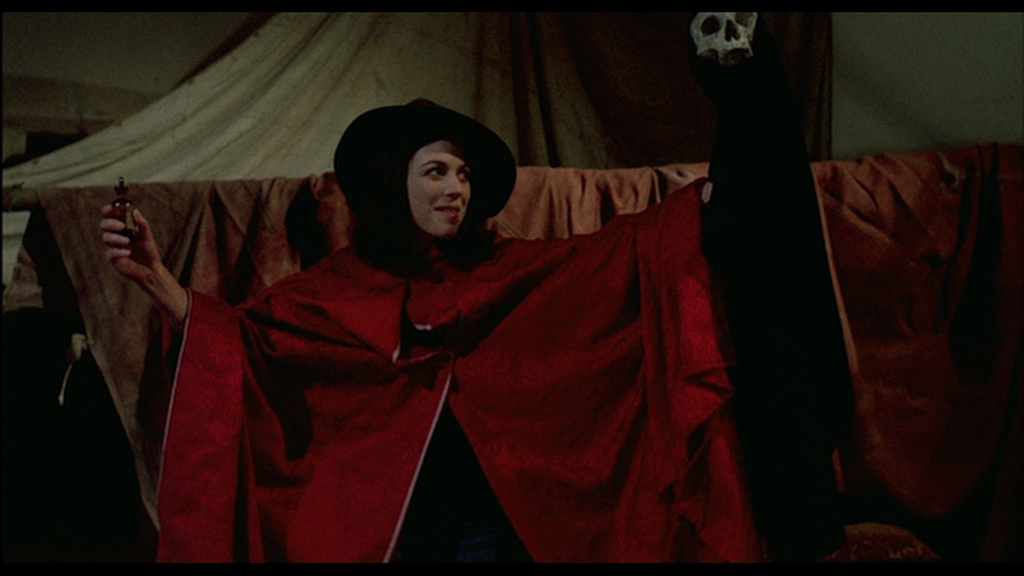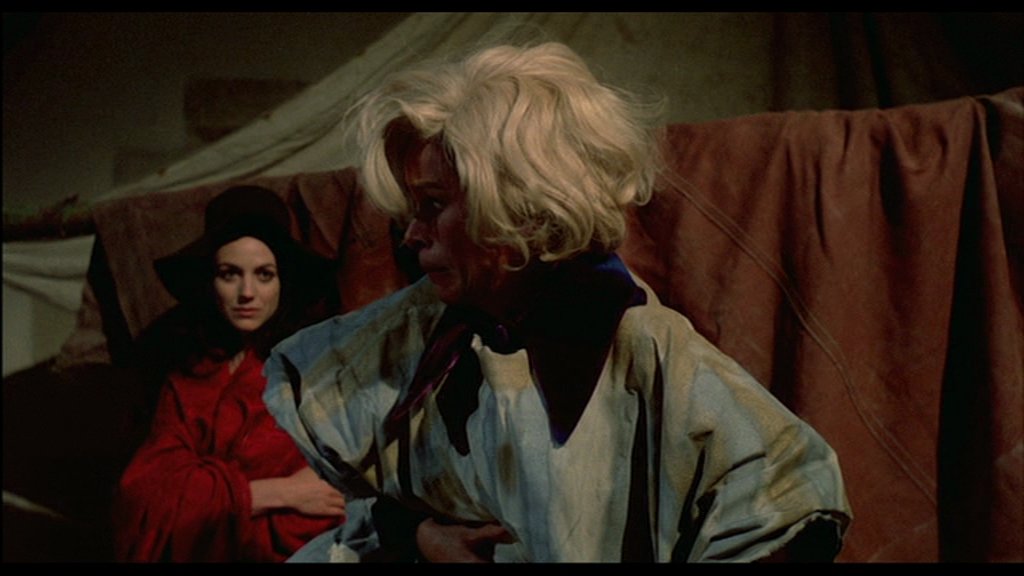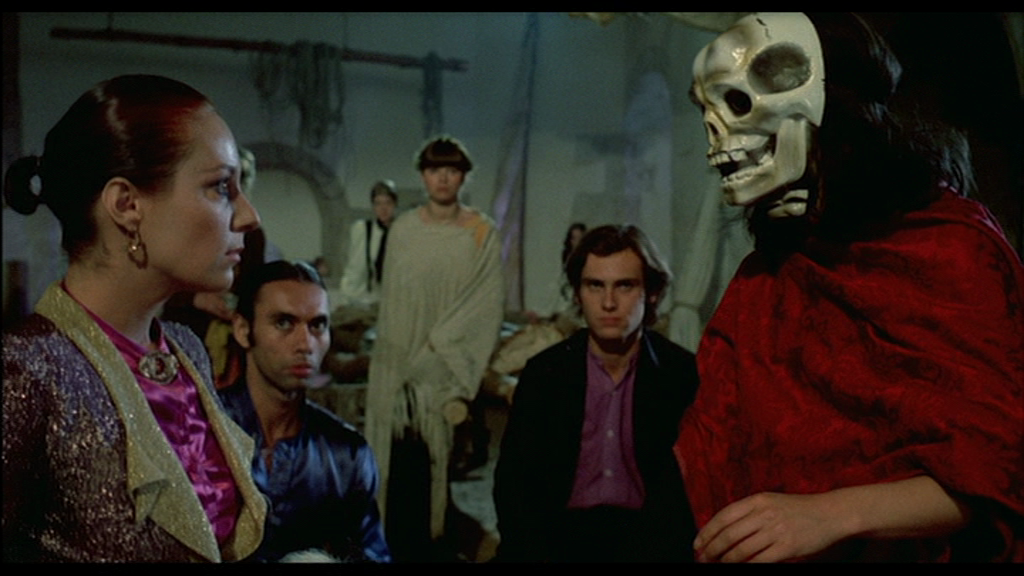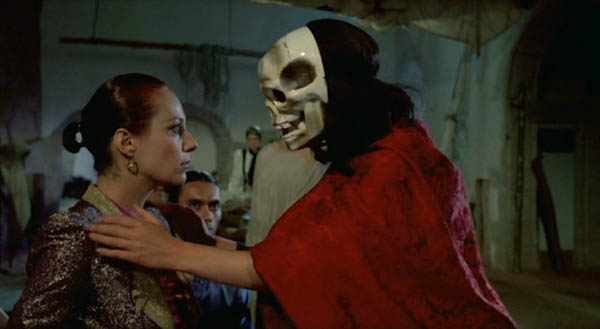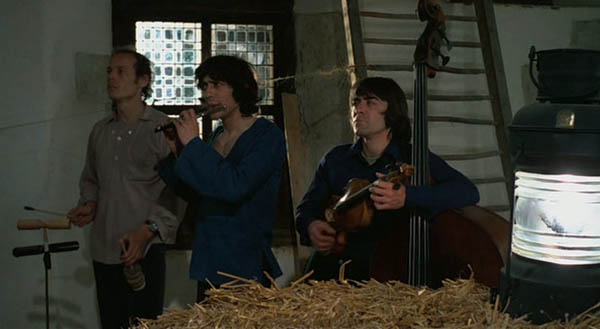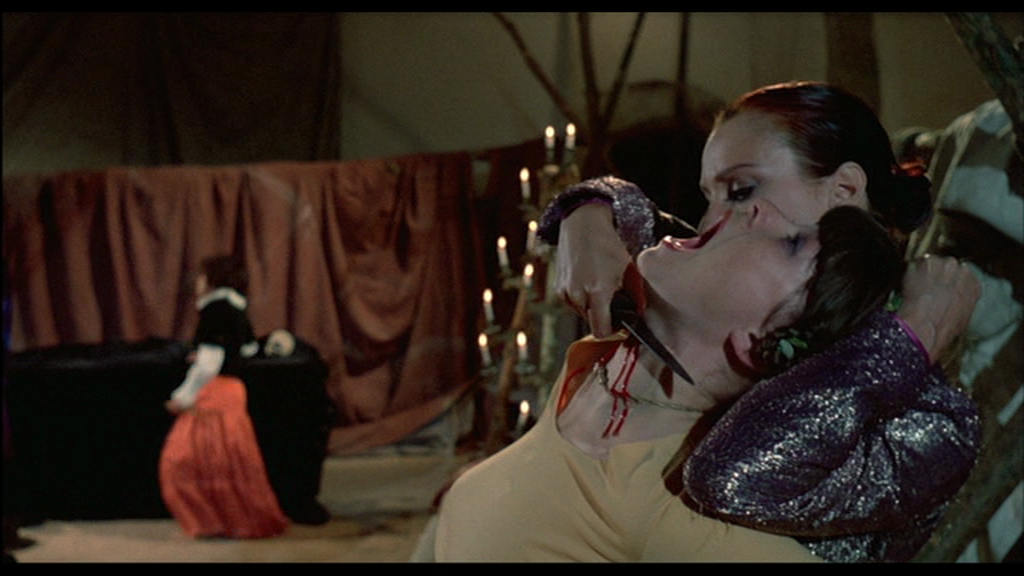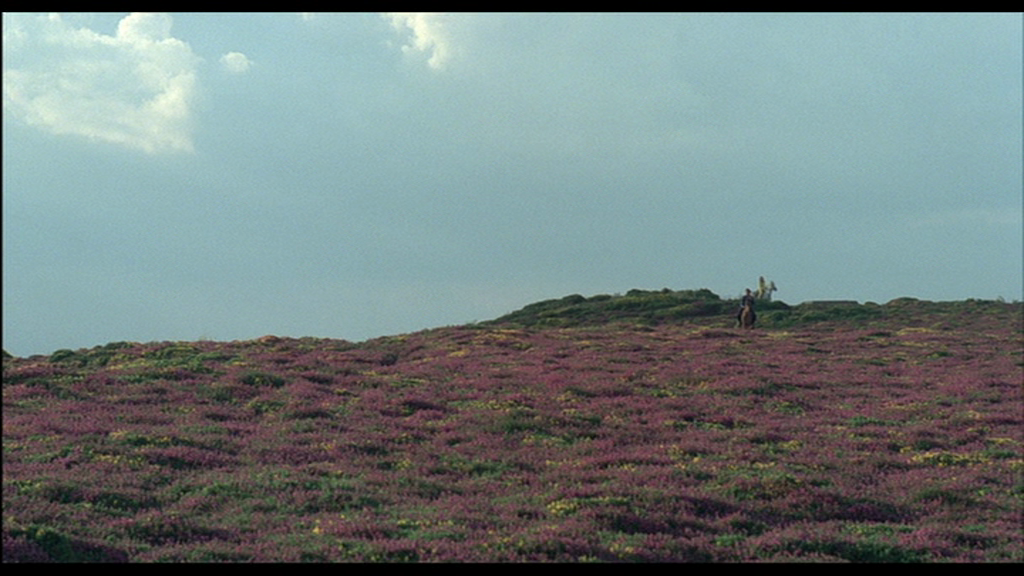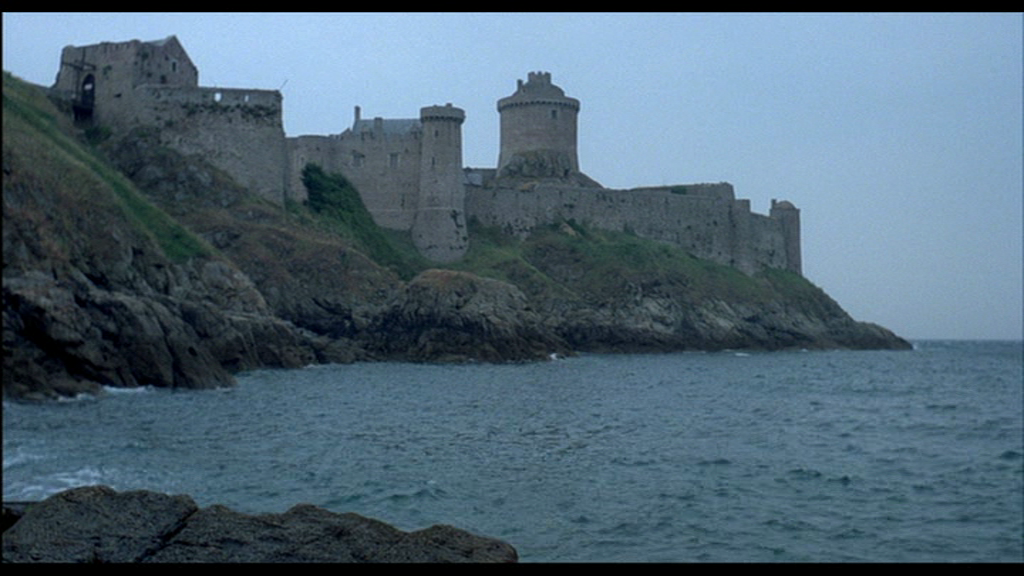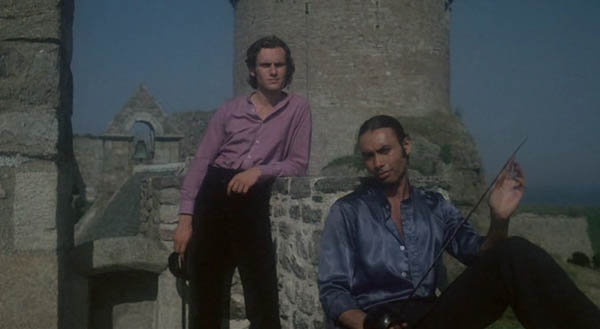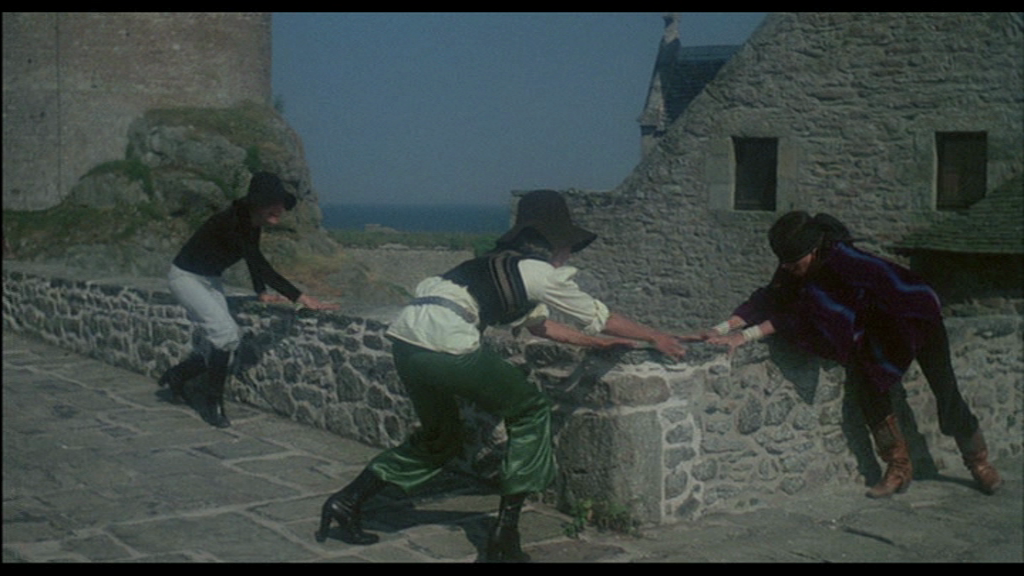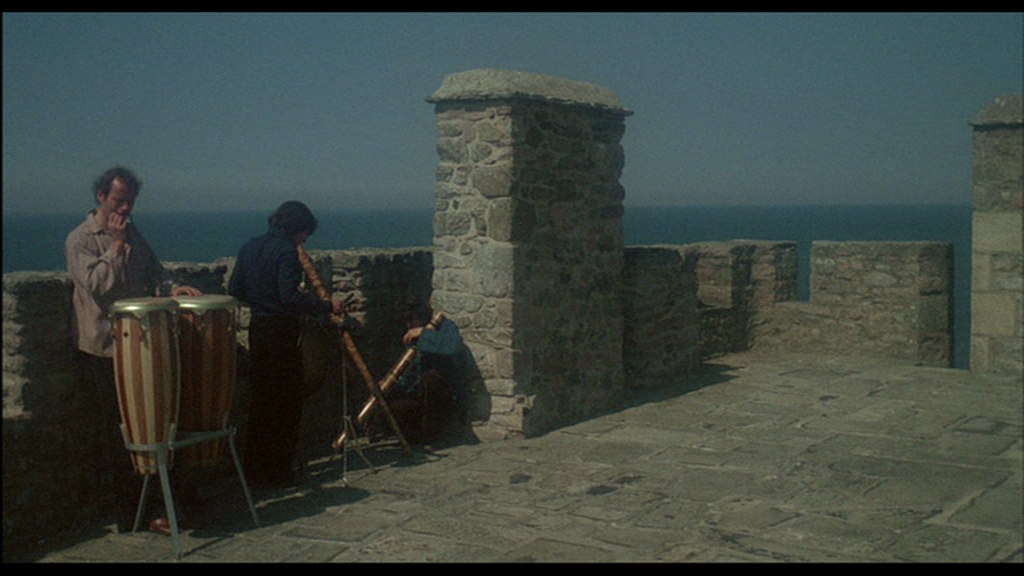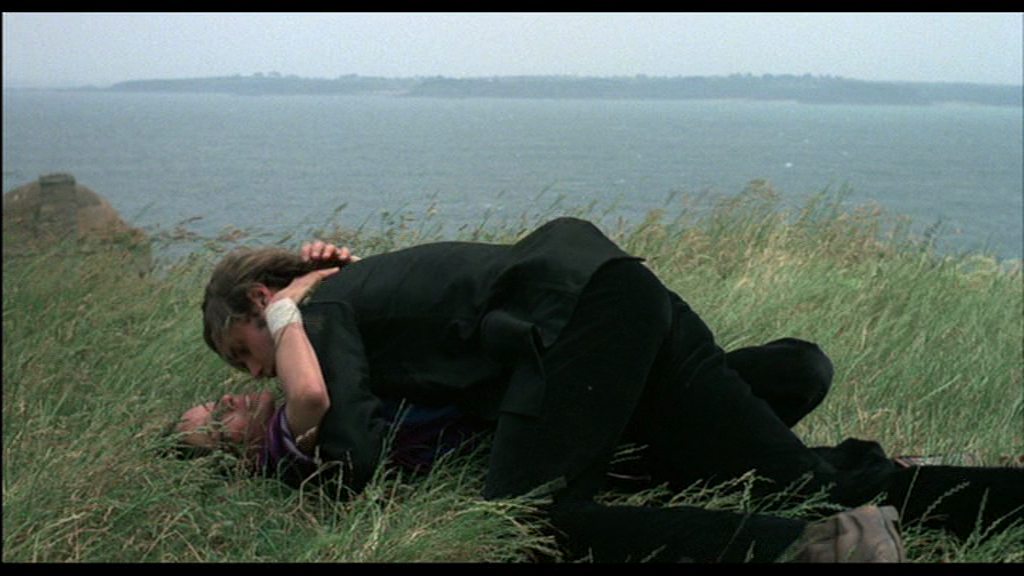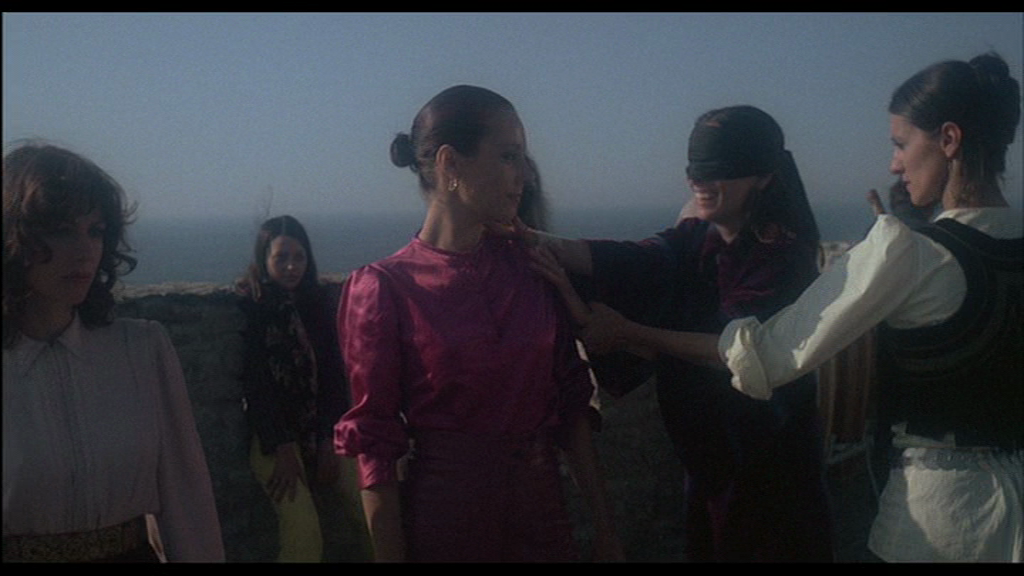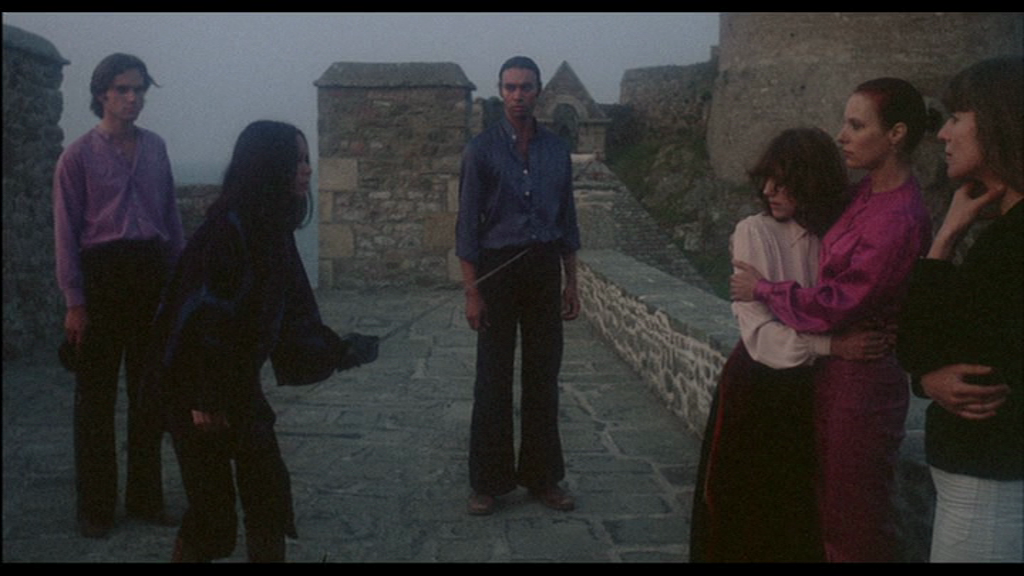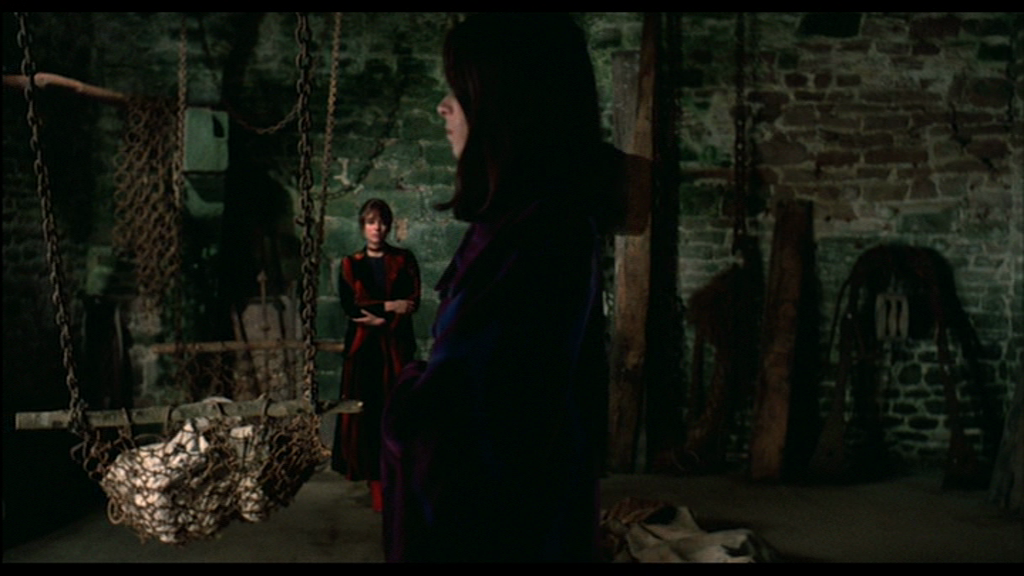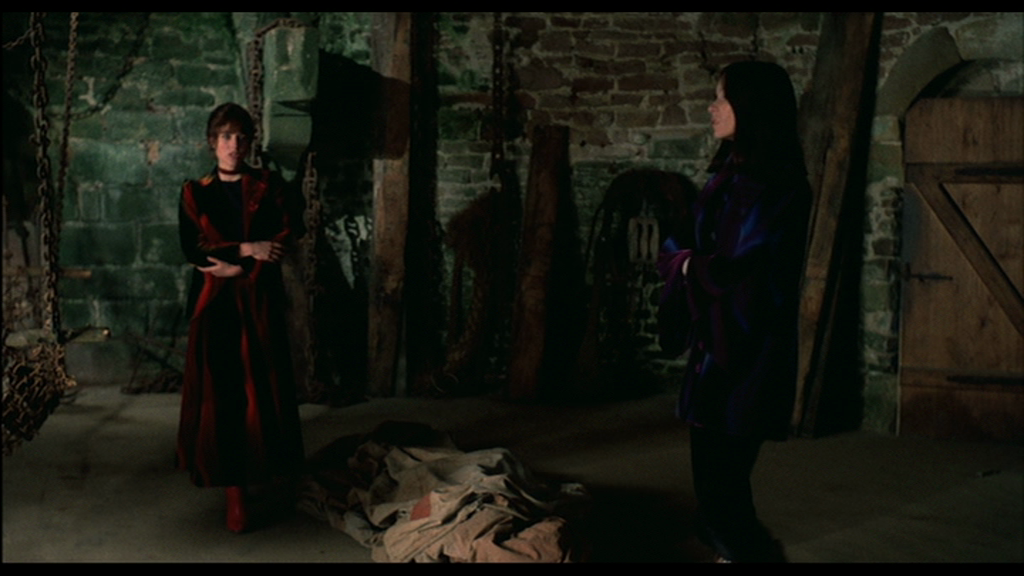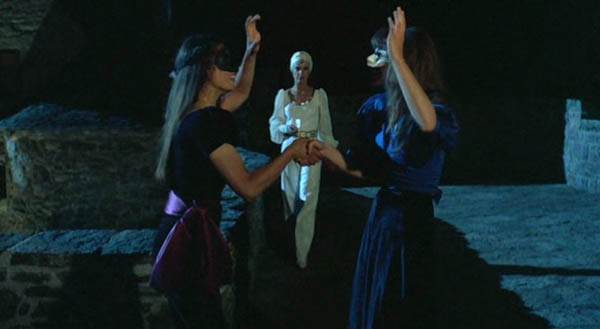From Sight and Sound (Autumn 1975).
I was shocked to learn yesterday [in December 2011] of the death of Gilbert Adair, a close friend during the mid-70s (when both of us were living in Paris, and for some time later, after I moved to London ahead of Gilbert). This collaborative article, which I instigated, assigning the middle sections to Gilbert and to Michael Graham (also, alas, no longer alive), is being posted now in memory of our friendship. (With Lauren Sedofsky, Gilbert and I had also already collaborated on an interview with Rivette the previous year, which was posted here yesterday.) And because of the unusual length of this article, I’m running it in two parts; the first half, with sections by me and Gilbert about Duelle, appeared a few hours ago. — J.R.
3
Like any Rivette film, Le Vengeur (2) took shape gradually, drawing on a large number of deliberately chosen ideas and as many fortuitous circumstances. As important as Rivette’s interest in Tourneur’s The Revenger’s Tragedy (drawn to his attention by Eduardo De Gregorio), and the curious traditions surrounding the period of Carnival, was the availability of Geraldine Chaplin and Bernadette Lafont together with that of a group of dancers from Carolyn Carlson’s company. It must be kept in mind that Rivette often conceives a film around particular people; Celine et Julie began as ‘a film for Juliet Berto’. Any casting decision is consequently of primary importance. Further, the selection of Brittany as a location arose as much from certain union allowances permitting a six day week outside Paris, as from a vague desire to spend some time in the country. Once the different ideas and practical considerations begin to sort themselves out and interact, the narrative itself starts to acquire definition. Even after shooting has begun, however, Rivette is enormously influenced by what he may discover the actors capable of achieving. Finding that an actor is able to do something he hadn’t suspected, Rivette might add a scene at the last minute (if, of course, there is time, of all things the most rare and precious). One of Rivette’s talents is his ability to begin rehearsing a scene without any fixed idea of how it will actually be played for the camera. The final outcome is invariably a product of close collaboration with his actors.
In this film, the elements of mise en scène, the use of costume, dance, and allusion, are so strikingly disparate that it would almost seem that Rivette purposely set out to amalgamate the most wildly divergent sorts of material. For the most part, the camera movements appeared to suggest an affinity with recent films of Jancso and with Fellini’s procedures in Roma, but the things which the camera had to photograph plunge one into the world of De Mille, or even of Raoul Walsh’s Blackbeard the Pirate. Certainly, the pointedly approximate nature of the costumes and the singular use of decor keep the players and the plot in a curious kind of cinematic limbo. The grating juxtaposition of assorted, eccentrically chosen verse from the play, with scenes that allude strongly to musical comedy, defies an attempt to comprehend the kind of synthesis that might eventually come to bear.
From watching different aspects of the shooting, even for so long a period as ten days, it is impossible to draw conclusions as to the final result. Nor must one rule out an alternative possibility: Rivette may be exploiting sharply contrasting effects in an attempt to keep the viewer in a continual state of discomfort as the gears grind joltingly back and forth. Considering the context, one is reminded of certain Renaissance plays where the tone remains so complex and ambiguous as never to be wholly tragic or wholly comic, where everything seems just barely contiguous, and where audience reactions remain confused and uncertain. There is no room here for improvised bits of dialogue and for the sorts of hesitations and temps morts that improvisation produces, effects which have been so remarkably utilized by Rivette in the past. While spontaneity is not sacrificed, the camera movements are of such complexity that great discipline is imposed on the actors.
Furthermore, while Rivette was present during the discussions leading to the creation of the script, he allowed Parolini and De Gregorio enormous freedom. It would perhaps be more, accurate to say that Rivette ‘relied’ strongly on’ material that they were able to provide independently of him. Virtually all the dialogue, with the exception of Tourneur’s verse and one brief scene, was invented by the two writers. It seemed an ideal collaboration in the sense that, being intimately familiar with Rivette’s work and methods, they were able to stimulate him to try things he might otherwise not have attempted.
In its broad lines, the film deals with a band of pirates led by Giulia (Bernadette Lafont) and infiltrated for purposes of revenge by Morag (Geraldine Chaplin) and her accomplice Erika (Kika Markham). As Morag wreaks havoc among the pirates, it becomes clear that she is a moon goddess waging war with a sun goddess — who, is of course Giulia. There is no dearth of violent death; it abounds in the best Jacobean manner, until finally there are no survivors at all. There are drownings and throat-cuttings, poisonings and death by lightning. A special end was invented for Erika, who is mysteriously described as being ‘eclipsed’.
The first two weeks of shooting took place, in the 15th century Chateau de la Roche-Jagu. Outside and in, the chateau had been so reconstructed and patched up that it had the air of having been built by an eccentric millionaire who wished to own a medieval castle as imagined by Paramount or RKO. Apart from this advantage of singularly recalling the Hollywood past, the rooms were large and gave the camera plenty of space in which to move.
While Tourneur’s play may have been a starting point for Rivette and his writers, the transformations it underwent at different stages of preparation and shooting are so far-reaching that the play itself is of only minor importance. Rivette has retained the lushness of violence typical of Jacobean horror shows, but he has wandered far from The Revenger’s Tragedy. At one point, Morag and Erika present a scene from the play to Giulia and her cohorts, the scene having been chosen because it represents a murder similar to one that they had recently perpetrated on a member of Giulia’s band. But even here, the allusion is through Tourneur to Hamlet; not only is the play put on before the corrupt little court in the hope of eliciting a violent reaction, but except for a few fragments of. verse dredged up by the actresses — bits of one line violently grafted on to bits of another — the scene is presented in dumb show, modified by assorted cries, squeals and gasps. Their recitation is a parody of melodramatic excess; Erika chases Morag around the room, attacking her with a variety of lethal weapons.
Music plays an even more important part in Le Vengeur than in Viva. Here there are three musicians playing perhaps a dozen instruments between them, from traditional flutes and violins to more exotic instruments from Africa and South America. Their sensitivity is wholly remarkable; again and again their musical choice is exactly right. They articulate the performance admirably and, in turn, are very much influenced by the rhythms and tones of the actors. In the dumb show, they punctuate the actresses’ cries, playing music of a marked 17th century color treated freely in post-Viennese fashion. There is no attempt to conceal them from the camera. In fact they have their own ‘costumes’, and are often in the frame by themselves.
An afternoon was spent filming a number of reverse shots, in which the pirates react to the little play. Their mirth changes to seriousness as they perceive that the death of one of their colleagues is being mocked. Giulia, unlike Claudius, innocent of the deed imitated by Erika and Morag, only begins to enjoy herself when she realizes that the play refers to recent events. Together with her two lovers, Jacob (Humbert Balsan) and Ludovico (Larrio Ekson), she laughs morbidly. Appalled at her callousness (and we know from Hollywood films that pirates can be a sensitive lot with a highly developed moral sense), the pirates rise up spontaneously; but Giulia’ suppresses this incipient revolt by slitting the throat of a female pirate. This murder called for special effects one doesn’t associate with Rivette, although Bulle Ogier bleeds quite a lot in Celine et Julie. An elaborate system of rubber tubes and little valves was employed, producing a distressing amount of gore. The victim’s screams, while undoubtedly an anatomical: impossibility, added to the scene. It was all very horrible and unsettling.
A scene in which lines were drawn directly from Tourneur’s play afforded a further glimpse of Rivette’s methods in shaping a scene. The actresses had chosen a dozen verses from different scenes in the play that they were to recite as though encouraging each other to see their vendetta through to the end. In one of the attics of the chateau, beautifully lit to suggest daybreak Erika and Morag were to pace the length of the room and speak their lines alternately in an incantatory manner, as they approached the camera. When the scene was ready to shoot, Rivette announced his dissatisfaction with the idea. For the next two hours the scene was discussed and slowly took an entirely different form; the principle of singsong recitation was wholly abandoned and the lines were spoken much as they might be on the English stage. While Morag paced nervously back and forth, Erika sat on a bed, in an attitude of dejection. Both actresses spoke their lines with great intensity accompanied by highly wrought little sounds from the musicians. The effect was far more austere than the more ritualistic initial idea and extremely dramatic.
M.G.
4
June 25-29: Fort La Latte, a 12th century fortress near St. Cast on the Brittany coast — entered by a drawbridge and surrounded by sea which is white and foamy against the rocks, green and translucent by the shore, blue and hazy in the distance. The last time a movie crew took over this spectacular location was nearly twenty years ago, for The Vikings, and a few placards from that invasion still linger in a nearby shed.
In comparison with what I watched months ago, Le Vengeur (again, a tentative title) seems even wilder and more disturbing; in its clash of foreign elements, a somewhat bigger risk and dare. The crew is the same as on Viva, the cast much more varied in terms of background and experience: Markham was Anne, the more worldly of the sisters in Truffaut’s Les Deux Anglaises et le Continent; Chaplin worked for directors as different as Saura, Lean, and Altman; Lafont is a seasoned New Wave and Out 1 veteran. Among Giulia’s band, four members are played by dancers including Arno (Anne-Marie Reynaud) her lieutenant, while Anne-Marie Fijal, a pianist, plays her jester Fiao; Balsan was Gauvain in Bresson’s Lancelot du Lac and Daniele Rosencranz was the female lead in Chabrol’s Une Partie de Plaisir; the part of Elisa, a teenage pirate, is taken by Elizabeth Medvecky, Lafont’s daughter.
Rather than try to be inclusive or to impose a continuity over several days of shooting, I will restrict myself to two of the more elaborate scenes I saw being filmed inside the fortress. But it might be relevant to quote two passages from a prospectus about Les Filles du feu written by Rivette a few months ago (the translation is mine):
The ambition of these films is to invent a new approach to film acting, where speech, pared down to essential phrases, precise formulae, would play a role of ‘poetic’ punctuation. Neither a return to silent cinema nor pantomime nor choreography: something else, where the movement of its bodies, their counterpoint and inscription in the space of the screen, will be the basis of the mise en scène.
To create by the movements of their bodies their own space, to take possession of and traverse the spaces imposed by the decor and the camera’s field, to move and act within (and in function to) the simultaneous musical space: these are the three parameters according to which our actresses and actors will attempt to work.
On the battlements: Giulia’s ‘reply’ to Morag and Erika’s enactment of the scene from Tourneur is to stage a nasty bit of theatre of her own — a swordfight between Jacob and Ludovico designed to convince Erika, who loves Jacob, that it is real. This is a pivotal scene in which Morag loses Erika as an accomplice, but I am around only for its preliminary stages, which consume parts of two separate afternoons of shooting and are disquieting enough in themselves.
The scene begins with Jacob and Ludovico entering from one side of the battlements, passing the musicians on their way, and rehearsing their swordfight — a rehearsal which Balsan and Ekson have been rehearsing in their spare time, with a trainer, over the past few days — before they retreat to a corner and rest. The camera pans with them throughout except for when they first take their positions, when it tracks away from them, moving approximately from medium to long shot.
The next two shots, running about 90 seconds each, follow the entrances of Morag, Arno and Fiao and their frolics as they play blindman’s buff in the same spot occupied by the rehearsed fight, with Morag, as the blindfolded victim; the camera tracking as they dance about. Although Chaplin can see through her black blindfold, this is not apparent to the off camera bystanders when she enters, and here are several unnerving instants when she nearly topples over the edge of the vertiginous battlements as Arno and Fiao buffet her about like malicious children.
The musicians have been improvising visibly throughout the sequence, between as well as during each of the takes, so that each run-through of a shot becomes appreciably different from the one preceding it. In the next shot, also running close to 90 seconds, their apparent autonomy from the action is given a disconcerting wrench when Elisa enters, a mischievous grin on her face, and playfully hits a gong and taps a conga drum as she passes them. (A day later, I learn from one of the musicians that this was Rivette’s idea.) Behind her comes Erika and Giulia, and a flute starts to play over the light percussion; the camera pans back to frame their entrance, finally settling on Erika as she stares blankly into space.
A stationary set-up shows Ludovico step up behind her with his sword, ready to provoke the fight, and jab her in the back. She cries out sharply, as though waking from a nightmare, spins around and steps to one side. By now it is the second afternoon, and a strong, flappy wind comes over the battlements from the sea (a few hours ago, it gave a love scene between Morag and Jacob on a hillside a distinct Wuthering Heights flavour); the mood is tense and edgy, and the musicians’ playing becomes increasingly ceremonial in sound from one take to the next, suggesting some sort of blood sacrifice….
A stationary set-up shows Ludovico step up behind her with his sword, ready to provoke the fight, and jab her in the back. She cries out sharply, as though waking from a nightmare, spins around and steps to one side. By now it is the second afternoon, and a strong, flappy wind comes over the battlements from the sea (a few hours ago, it gave a love scene between Morag and Jacob on a hillside a distinct Wuthering Heights flavour); the mood is tense and edgy, and the musicians’ playing becomes increasingly ceremonial in sound from one take to the next, suggesting some sort of blood sacrifice….
In the dungeon: Morag and Erika enter and stalk round the body of Morag’s dead brother Shane — who, for reasons that are unexplained, looks exactly like Jacob and is played by the same actor — reciting lines from Tourneur (in English) which they will subsequently use in the scene that they stage for Giulia and her band. This time their delivery is strictly incantatory and ritualistic, their voices overlapping as Erika echoes Morag, repeating the same edited speech several times:
Now to my tragic business.
I have not fashioned this only for show
And useless property; no, it shall be a part
E’en in its own revenge. This very skull,
With this drug,
The mortal curse of the earth shall be
revenged.
The musicians play off-camera in a cramped chamber behind the bright lights being used in this dank interior, stopping and starting their dirge — a drawling bowed bass and a cymbal struck with mallets — in accordance with the simultaneous pauses of Chaplin and Markham in their recitation and pacing. This accompaniment becomes increasingly hypnotic through all five takes, and I’m hardly surprised to hear from Markham afterwards that she wasn’t even aware of the music playing, so completely had it become absorbed by and blended into the action of the scene.
The separate circular trajectories of the actresses round the body on the floor — wrapped from head to foot in sailcloth — and a hammock made of chains which hangs beside it, arc complex indeed, and my efforts to trace them in my notebook lead to an impenetrable jumble. Each take improves on the last as Rivette slows the action down and stretches it out: the first runs for 112 seconds, the last for 140. The script-girl informs me that the longest take. the film so far is 230 seconds; but this is nothing compared to a few separate shots of Michael Lonsdale’s theatre group in the 13-hour, 16mm Out 1, which apparently ran over ten times longer.
The shot ends with both actresses kneeling beside the body and Morag drawing out her knife (there are some smiles from the crew each time Rivette says ‘Cut’). In the next shot, which shows them tearing apart the fabric to look at Shane, the camera assumes a low angle and becomes mobile, pushed forward on wheels in a path which somewhat resembles an inverted S — beginning at the top end of the figure and proceeding towards Shane’s features in horizontal profile before panning up to Morag’s face — a manoeuvre that requires Markham to move our of her position silently when the camera approaches. No music this time, only the sound of ripping cloth as Balsan in his heavy corpse make-up gets unveiled through several retakes…
As Michael Graham suggests above, Rivette’s route into a scene is often trial by error, and it appears that his customary method of composing a plot with his writers is to ask for a string of suggestions, systematically rejecting each of them until he arrives at what he likes. When I ask Geraldine Chaplin about his manner of directing performances, she describes a process which again seems similar: ‘Rivette is very positive that he doesn’t know what he wants. But he knows what he doesn’t want — and he’s very particular, too. He’s very tough. You have to invent thirty-five different ideas and show them to him like you were selling carpets, and then he says, “Okay, do that.” But it’s exhausting.’
This kind of aggressive passivity has led to a different formula for group collaboration on each of his projects, but in each case it appears to be grounded in the habits of a spectator-critic, a person more accustomed to watching and evaluating what he sees than to creating something ex nihilo for someone else to see — a desire to experiment which seems born out of sheer curiosity, the question ‘What would happen if…?’ Perhaps this is why he usually places so much importance on editing, where questions can be asked and asked again. It will be interesting to see how much he can do with editing in these films, when so much of the footage is composed of long takes, the plots are extremely dense, and there evidently isn’t enough material to make lengthy features out of them. Whatever emerges, one suspects that it will only extend the question about authorship that each of his films since L’Amour Fou has raised.
The closer emphasis and attention in Les Filles du feu on framing, composition, camera movements, actors’ movements and all the other physical coordinates of mise en scène will undoubtedly produce some changes in what we suppose a ‘Rivette film’ to be, and in the process will likely raise more questions about many things than they begin to resolve. The excitement and adventure of a Rivette project is quite literally that of a leap into the unknown — a form of suspense and suspension that begins when it is first conceived, grows and deepens while it is being filmed and edited, obstinately persists well past the point when the film is completed, continuing in the mind of each spectator who sees it and interrogates it in his own fashion.
J.R.
NOTES
- L’Oeil Froid and Viva were working titles for Duelle (1976).
- Le Vengeur was the working title for Noroît (1976).


